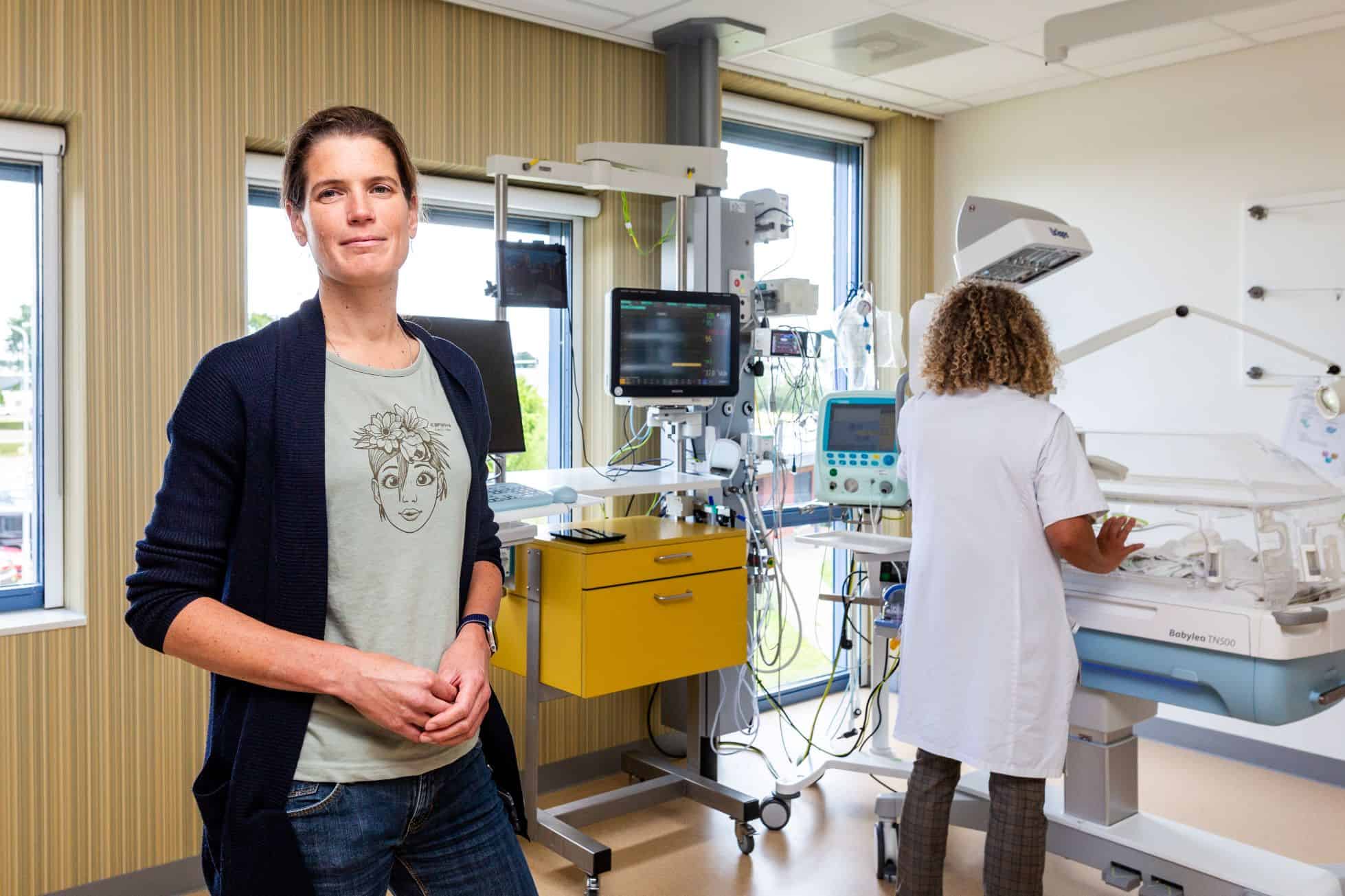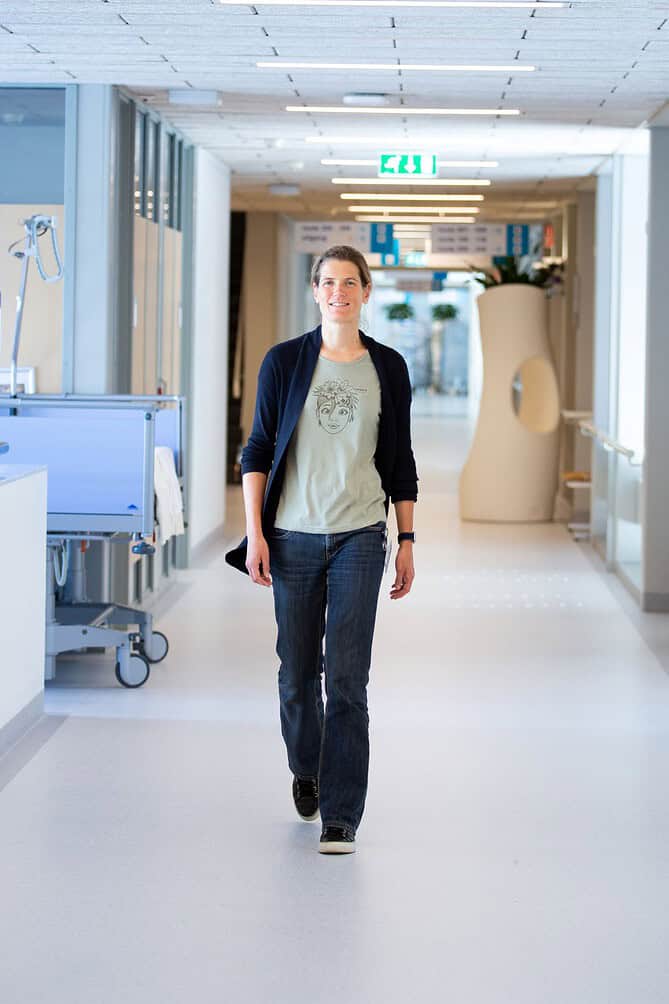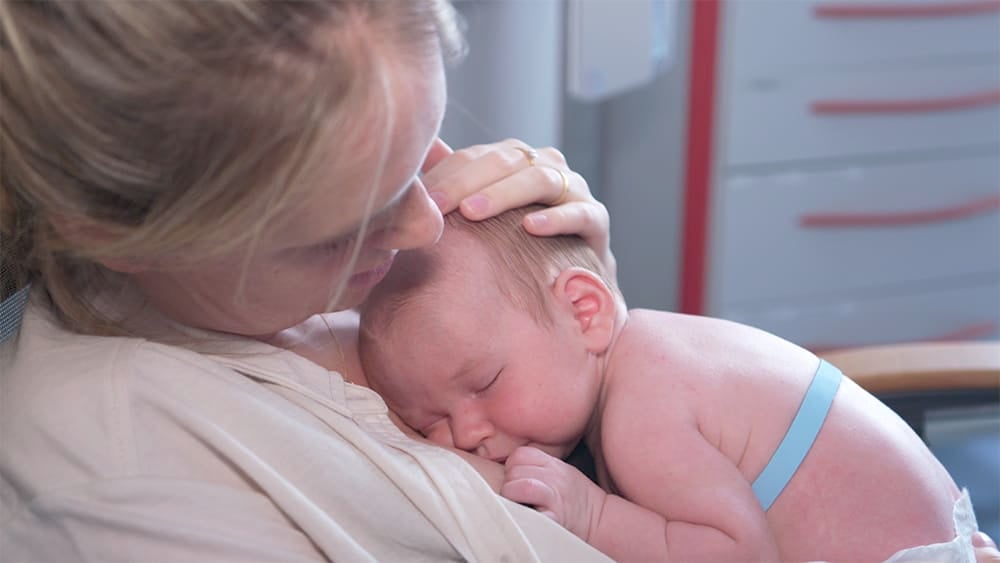
“Every day, I look at how we can use technology to give babies a better start,” says Carola van Pul, clinical physicist at Máxima MC (MMC) and professor of clinical physics at the Eindhoven University of Technology (TU/e). She researches how technology can improve the treatment of patients in the hospital and has focused in recent years on improving technology in the Neonatal Intensive Care Unit (NICU). “Newborns lie in big, buzzing incubators to keep them warm, with a lot of beeping and flashing devices around them. To ensure thorough monitoring of all their processes, their tiny bodies are covered in stickers fastened to cables. That’s not a comfortable situation,” Van Pul said.
To change that, one of the things she is working on is the development and implementation of new sensors that do not adhere to stickers but are under the mattress. Some sensors can measure specific data with a wireless, soft band. “That way, a premature baby’s skin doesn’t get damaged and is much more comfortable. Wireless sensors make it easier for parents to hold and care for their babies. This is essential for the bond between parent and child. Moreover, pouching (skin-to-skin contact, ed.) is good for a baby’s development and growth.”
Why is this important?
A baby with a bad start – due to premature birth, for example – needs intensive care. Carola van Pul and her colleagues strive to provide the best and most comfortable care possible.
Birth is fascinating
On June 7, 2024, Van Pul delivered her inaugural address during MedTech Day at Eindhoven University of Technology. Last year, she was already appointed professor of clinical physics. Van Pul talks passionately about her profession. Why did she choose the NICU? “I find the birth of a child incredibly fascinating from a biological point of view. So much happens in a short period of time, the baby goes to a completely different blood circulation, for example,” she outlines. She herself is a mother of two children. “The birth often goes well, and the parents are then on a pink cloud. But so much can also go wrong, such as premature birth or complications during labor. Then we want to be able to do everything we can to give these babies the best possible start.”
Early Birth
In the Netherlands, about 7 to 8% of children are born prematurely, that is, before 37 weeks of pregnancy. These babies often need extra care, partly in the NICU. Especially severe premature babies – born before 32 weeks of pregnancy – often receive intensive and long-term care.
Early warning

In recent years, Van Pul – together with a team of doctors and nurses – has been working on the development of early warning systems. As the name suggests, these systems notice changes in the body early. “Now the system is set up so that the alarm only goes off when the baby’s health is critical, for instance, when the heart rate and saturation drops drastically. We can often see such a situation coming up. Therefore, we are now developing mathematical models to predict a critical situation earlier.” For example, heart rate variability often changes before the heart rate actually drops. Motility is another crucial indicator; a baby often moves considerably less when things are not likely to go well.
Developing early warning systems for premature infants is more complex than for children or adults because factors such as heart rate and respiration develop rapidly and are constantly changing. “So the system has to be able to correct for that,” Van Pul explains. If the system eventually works well, it will benefit the infants, their parents, and nurses. “Nurses get a signal that allows them to intervene earlier, for example, by adjusting medication. In this way, we hope to prevent some of the critical moments. That also gives the little patients and their parents more peace of mind.”
But with just an early warning system, we are not there yet, Van Pul outlines. “The system can send signals, but it still has no effect if the nurses are not in the room. That’s why we want the nurses to receive a signal on a portable device they already have. That way, they can respond immediately, and the rooms will be quieter. So the early warning systems have to connect to the ICT network.”

Data importance
Before the early warning systems were widely used in practice, we are still several years away, Van Pul points out. “We are still in the middle of development. There is now one commercial system with the CE mark, but it still gives many false alarms. A lot of training is still needed to make the algorithms work optimally.” A system may work in one hospital, but that does not mean it will work everywhere. Data are measured or structured differently everywhere, and that affects the system. “That’s why it’s important to test new systems in different hospitals to see how the system works with different data. We will put more effort into that in the coming years.”
To do this, hospitals must be able and allowed to share data securely. This is where e/MTIC, a partnership between TU/e, Máxima MC, Catharina Hospital, and Kempenhaeghe Epilepsy and Sleep Center, plays an important role, according to the clinical physicist. e/MTIC is developing a Health Data Portal to share data safely and efficiently. “This is how we enable the connection between the university, hospitals, and industry. Eventually, it is important to get innovation into practice as well.

